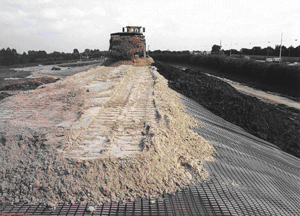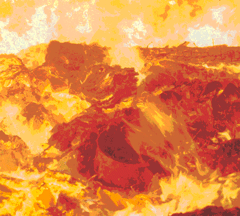
NextGenBioWaste
Residue handling and use - SP3
Practices in some of the European countries confirm the technical possibilities to utilize the bottom ashes as an embankment material in road construction. In other European countries utilization is negligible. Helping to increase the share of bottom ash utilization in other countries is one of the targets of the NextGenBioWaste project.
Objective
This subproject concentrates around the following aspects:
- What is the present quality of MSWI residues in Europe and specifically in the countries of participants, mainly for bottom ashes and partly for APC residues
- Marketing approach and restraints for MSWI bottom ashes, with the purpose to increase market penetration
- Develop and demonstrate innovative ash management practices which will upgrade the ashes to regular construction materials, thereby reducing the quantity of ashes that has to be landfilled.

|

|
|
Utilization of MSWI bottom ashes as a road embankment material |
Ashes from incineration |
State of the art
For bottom ashes from waste incineration plants practices throughout Europe can consist of the following items:
- Landfilling (in some countries together with fly ashes and APC residues)
- Regular dry classification, combined with removal of iron parts, followed by utilization
- Sometimes non ferro separation
Only in some European countries significant quantities of bottom ashes are being utilized for road construction and similar purposes. The quality and the extent of upgrading of the ashes have a direct influence on the marketing potential of the solid waste incineration bottom ashes. The quality of the ashes is influenced by the input quality of the ashes, the effectiveness of the incineration on the grate, the intensity of wetting at the ash discharge and the extend of upgrading. The development of new incineration concepts may have an effect on by products quality that is not yet fully understood.
In several European countries legislation is in operation to protect the environment from the potentially adverse effects of leaching from construction materials in general or from specific waste materials such as bottom ashes. The legislation and also the test methods are different per country.
The general focus in assessment of bottom ash quality is on the environmental impact of bottom ash applications and great efforts have been made to understand the underlying processes for upgrading the ashes with respect to leaching quality. The following groups of upgrading techniques have been considered and tested on lab scale and pilot plant scale and may be used for the upgrading of bottom ashes.
- Wet extraction and separation
- Artificial or extended natural aging
- Solidification and stabilization.
Less attention has been paid towards the relation between the process conditions in the incinerator and the leaching behaviour of the ashes.
For fly ashes the main focus of development work is on improving the leaching behaviour and on the reduction of dioxin contents. By upgrading leaching behaviour an upgrade towards more lenient landfill conditions may be possible.
Activities
In SP 3 Residue handling and use the following activities are planned:
- Quality determination of waste incinerator products; this will include leaching quality and civil engineering quality such as the aptness towards cementing
- Determination of relationship(s) between the process and the quality of the ashes
- Market study on general possibilities and constraints for the free marketing of bottom ashes throughout Europe and for the specific countries within the consortium
- Demonstration of an artificial aging installation for bottom ashes
- Evaluation of the possibilities of a multi purpose upgrading plant consisting of several unit operations from which tailor made bottom ash products for specific market questions can be prepared. Unit operations can consist of:
- Regular dry classification with removal of iron and non ferro
- Artificial aging
- Dry advanced classification to remove fine fractions
- Solidification and stabilization of bottom ashes
- Assessment of the technical and environmental performance of bottom ashes after upgrading
- Development of alternative schemes for advanced pragmatic upgrading of bottom ashes for the Italian situation